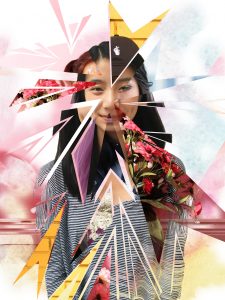One aspect of life narratives that I find really interesting is the topic of self-representation, the ability for the writers to create a specific image of themselves that they wish to portray through the selection of experiences they chose to include in their writing. In response to this self-creation, I am fascinated by the way people choose to represent themselves through digital media, especially with the readily access of editing apps. Digital media, specifically filming, played a central role in my high school years. When editing videos, one key piece of advice that is always followed when editing shots that contained people, is to pick and edit from shots that portrayed your actor/actress the best, and in a sense, creating their identities. The end goal was to show off their best side. In creating a self-portrait, I wanted to see how this similar goal is emulated through the usage of photography and digital media on myself.
 Erving Goffman’s theory of “audience segregation” depicts the idea that way we portray ourselves, our performances, varies between the groups of people we interact with (Goffman). In other words, the way we portray ourselves in one area of our lives, for example at school, does not carry on to other areas, like in our homes. This became evident when thinking about which parts of myself I wished to represent in the photo. Through social interaction, it is a lot easier to act a specific way around certain people. Working on an image for the blog, however, it proves to more difficult to ensure that one person looks at one specific portrayal of yourself, while another looks at a differing one. How do you create one coherent image that meets the expectations that you have set for yourself in your own respective areas of life? Which parts of yourself do you wish to share, and which parts do you wish to hide? How do you meet everyone’s approval? Consequently, I found myself wrapped up around the idea of my self-portrayal, and thus attempting to pick out the “best” qualities of myself, ones that would be universally seen as acceptable – identical to the mindset of video editing.
Erving Goffman’s theory of “audience segregation” depicts the idea that way we portray ourselves, our performances, varies between the groups of people we interact with (Goffman). In other words, the way we portray ourselves in one area of our lives, for example at school, does not carry on to other areas, like in our homes. This became evident when thinking about which parts of myself I wished to represent in the photo. Through social interaction, it is a lot easier to act a specific way around certain people. Working on an image for the blog, however, it proves to more difficult to ensure that one person looks at one specific portrayal of yourself, while another looks at a differing one. How do you create one coherent image that meets the expectations that you have set for yourself in your own respective areas of life? Which parts of yourself do you wish to share, and which parts do you wish to hide? How do you meet everyone’s approval? Consequently, I found myself wrapped up around the idea of my self-portrayal, and thus attempting to pick out the “best” qualities of myself, ones that would be universally seen as acceptable – identical to the mindset of video editing.
Through the use of fragmentation in my final image, I hope to represent the different complex aspects that work together to make up an individual’s identity. By taking different parts of various photographs, similar to how writers piece together a text through combining different passages, I realized the difficulty of creating one singular image. It was unfitting, at first, and very unpleasing to start with a few scraps of imagery, all of which seemed unable to balance each other out. As you keep editing, however, you gain a sense of direction in terms of where you want your image to go, and in doing so, a sense of the overall identity you are creating through the image. I wonder if this experience imitates the experience of life writing, and the sense of character gained through piecing together various fragments.
Works Referenced
Goffman, Erving. “The Presentation of Self in Everyday Life.” New York: Anchor Books, 1959. Print. pp. 139-145.
